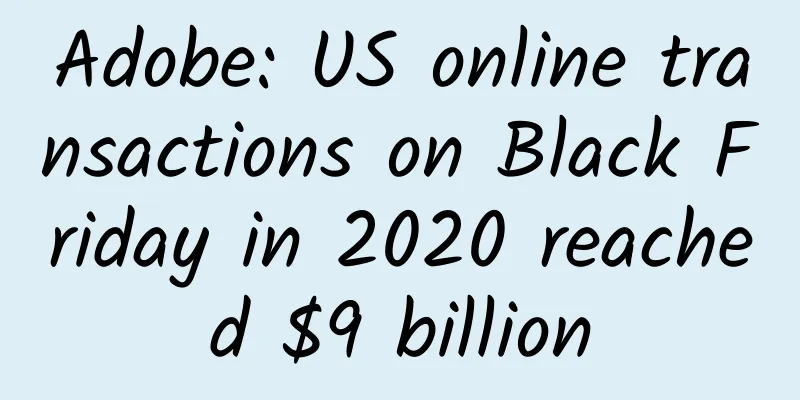Adobe: US online transactions on Black Friday in 2020 reached $9 billion

|
The COVID-19 pandemic is changing the way American consumers shop. According to estimates by Adobe Analytics, online transactions on Black Friday on the 27th hit a record high, up 22% from the same period last year. [Online transaction volume surges] Black Friday is the day after Thanksgiving, marking the start of the Christmas shopping season. With the rise of online shopping, more consumers choose to place orders online during Black Friday, and this year's COVID-19 pandemic has exacerbated this trend. Adobe Analytics tracks online spending and estimates that online transactions in the United States on Black Friday this year reached $9 billion, breaking the previous record of $7.4 billion set on Black Friday last year, a year-on-year increase of 22%. Toys, headphones and TVs are hot sellers online. This year, the online transaction volume of large and small retailers in the United States has increased significantly. According to data from Adobe Analytics, the online transaction volume of large retailers such as Walmart , the largest chain retailer in the United States, and Target, a daily groceries chain , increased by 403% during Black Friday compared with the daily average in October, while that of small retailers increased by 349%. The analysis firm predicts that the record for online transaction volume in the United States may be refreshed on the 30th, with an estimated transaction volume of US$10.8 billion to US$12.7 billion. In the view of Adobe Analytics, one of the reasons for the increase in online transaction volume on Black Friday is that the epidemic has caused people to shift their offline shopping to online, such as daily necessities and alcohol. [Offline customer traffic drops sharply] Data released by Johns Hopkins University in the United States on the 27th showed that the number of newly confirmed cases of COVID-19 in the United States exceeded 200,000 for the first time in a single day, and the cumulative number of confirmed cases exceeded 13 million. Affected by the epidemic, major physical stores have limited the flow of customers during the "Black Friday" period, limiting the time for customers to shop on site and the scale of the door-to-door rush. According to data from the American-funded solutions company Foresight, during this year's "Black Friday", the flow of customers to physical stores in the United States decreased by 52%, and the sales of physical stores decreased accordingly. Data released by the "Future Retail" data analysis company showed that in offline transactions on "Black Friday", sales of jewelry and footwear fell the most, apparel fell 50%, and home furnishings fell 39%. Even so, Brian Field, senior director of global retail consulting at Foresight Solutions, believes that Black Friday may still be one of the largest offline shopping days in the U.S. this year. In his opinion, many consumers will still visit physical stores during the Christmas shopping season, but will avoid weekends with large crowds, because online shopping delivery time is usually longer and physical stores may offer greater discounts. |
<<: Constant Contact: 2020 Small Business Survey
>>: Yieldify: 2020 Peak Season Report
Recommend
Technology Morning News | Man-made spacecraft touches the sun for the first time
News Station Photo by Xinhua News Agency reporter...
The efficacy and function of white thorn flower
White thorn flower is something that many people ...
What signs will your body give you before sudden cardiac death? Remember them!
《Cotton Swab Medical Science Popularization》 Yang...
What are the taboos of Lanxiangzi?
When it comes to Lanxiangzi, you may not be famil...
Can't tell the difference between DNA, genes and chromosomes? A picture will help you figure it out
With the booming development of life sciences, we...
When it comes to high school, is it so important to go to a prestigious school?
Across the country, the annual registration proce...
What is pine pollen good for?
More and more people are talking about health pre...
Why is it so hot this year?
Mixed Knowledge Specially designed to cure confus...
The efficacy and function of Huajuhong
There are many commonly used medicines in life, a...
Fire hazard, did you know that the airway can also be "very injured"?
This is the 4864th article of Da Yi Xiao Hu In re...
Saffron beauty treatments
I believe many of my friends know that saffron ca...
Consumer Intelligence Research: Amazon Prime membership hits record high in the U.S. at 180 million
Amazon's (AMZN) Prime subscription service hi...
One hour of sun exposure and 10 kilometers of battery life: Lightyear-1's journey of technological innovation
Your browser does not support the video tag Autho...
Top 10 common cancer misconceptions: Are you one of them?
A report from the World Health Organization (WHO)...
What does the Earth look like from space? These images are guaranteed to be something you've never seen before!
From ancient times to the present, weather observ...









